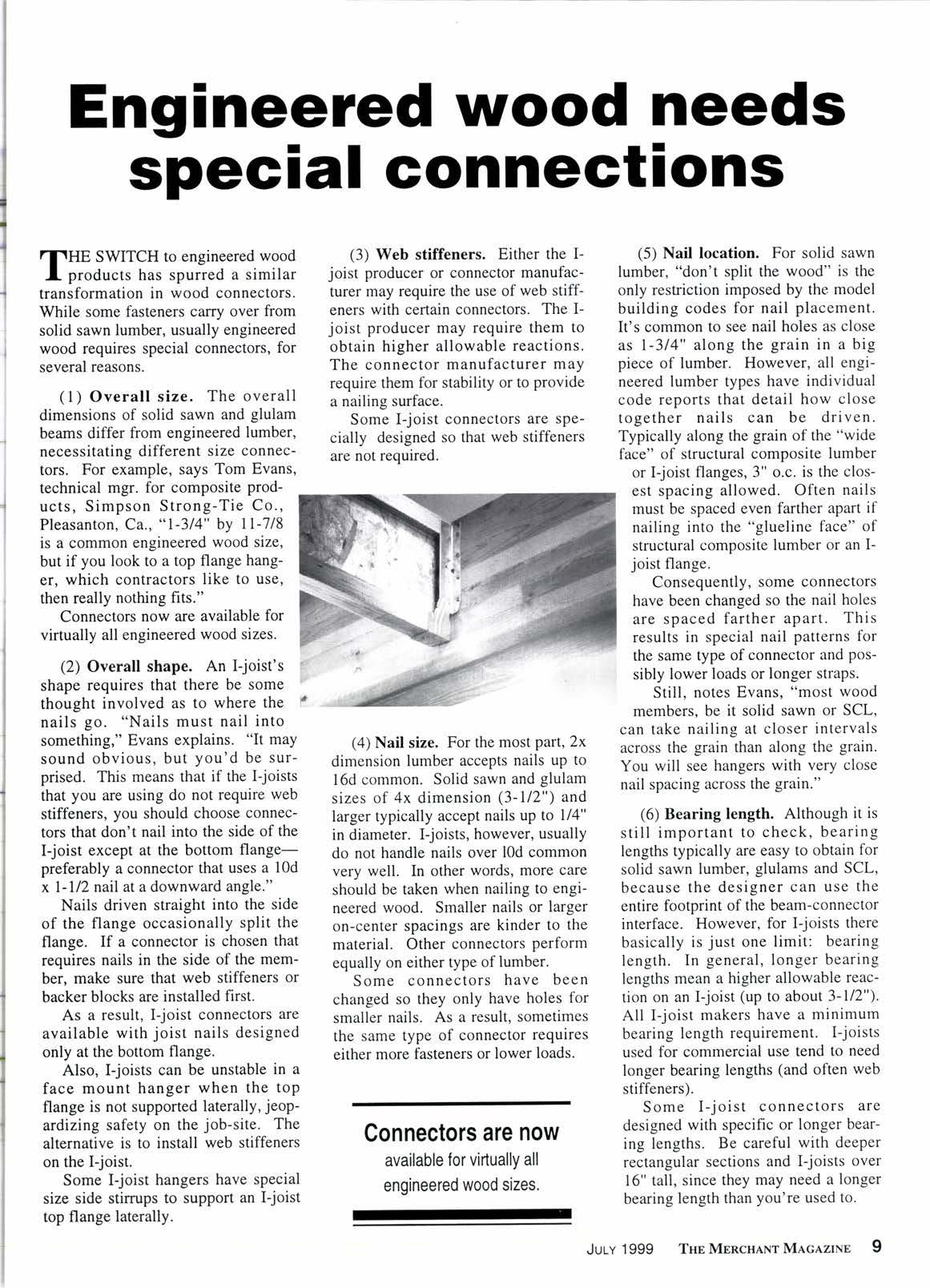
3 minute read
Engineered wood needs special connections
rnHE SWITCH to engineered wood I products has spurred a similar transformation in wood connectors. While some fasteners carry over from solid sawn lumber, usually engineered wood requires special connectors, for several reasons.
(1) Overall size. The overall dimensions of solid sawn and glulam beams differ from engineered lumber, necessitating different size connectors. For example, says Tom Evans, technical mgr. for composite products, Simpson Strong-Tie Co., Pleasanton, Ca., "l-3/4" by ll-718 is a common engineered wood size, but if you look to a top flange hanger, which contractors like to use, then really nothing fits."
Connectors now are available for virtually all engineered wood sizes.
(2) Overall shape. An I-joist's shape requires that there be some thought involved as to where the nails go. "Nails must nail into something," Evans explains. "It may sound obvious, but you'd be surprised. This means that if the I-joists that you are using do not require web stiffeners, you should choose connectors that don't nail into the side of the I-joist except at the bottom flangepreferably a connector that uses a 10d x l'll2 nail at a downward angle."
Nails driven straight into the side of the flange occasionally split the flange. If a connector is chosen that requires nails in the side of the member, make sure that web stiffeners or backer blocks are installed first.
As a result, I-joist connectors are available with joist nails designed only at the bottom flange.
Also, I-joists can be unstable in a face mount hanger when the toP flange is not supported laterally, jeopardizing safety on the job-site. The alternative is to install web stiffeners on the l-joist.
Some I-joist hangers have special size side stimrps to support an I-joist top flange laterally.
(3) Web stiffeners. Either the Ijoist producer or connector manufacturer may require the use of web stiffeners with certain connectors. The Ijoist producer may require them to obtain higher allowable reactions. The connector manufacturer maY require them for stability or to provide a nailing surface.
Some I-joist connectors are specially designed so that web stiffeners are not required.
(5) Nail location. For solid sawn lumber, "don't split the wood" is the only restriction imposed by the model building codes for nail placement. It's common to see nail holes as close as l-314" along the grain in a big piece of lumber. However, all engineered lumber types have individual code reports that detail how close together nails can be driven. Typically along the grain of the "wide face" of structural composite lumber or I-joist flanges, 3" o.c. is the closest spacing allowed. Often nails must be spaced even farther apart if nailing into the "glueline face" of structural composite lumber or an Ijoist flange.
Consequently, some connectors have been changed so the nail holes are spaced farther apart. This results in special nail patterns for the same type of connector and Possibly lower loads or longer straps.
(4) Nail size. For the most part,2x dimension lumber accepts nails up to l6d common. Solid sawn and glulam sizes of 4x dimension (3-ll2") and larger typically accept nails up to l/4" in diameter. I-joists, however, usually do not handle nails over lOd common very well. In other words, more care should be taken when nailing to engineered wood. Smaller nails or larger on-center spacings are kinder to the material. Other connectors perform equally on either type of lumber.
Some connectors have been changed so they only have holes for smaller nails. As a result, sometimes the same type of connector requires either more fasteners or lower loads.
Still, notes Evans, "most wood members, be it solid sawn or SCL, can take nailing at closer intervals across the grain than along the grain. You will see hangers with very close nail spacing across the grain."
(6) Bearing length. Although it is still important to check, bearing lengths typically are easy to obtain for solid sawn lumber, glulams and SCL, because the designer can use the entire footprint of the beam-connector interface. However, for I-joists there basically is just one limit: bearing length. In general, longer bearing lengths mean a higher allowable reaction on an I-joist (up to about 3-112"). All I-joist makers have a minimum bearing length requirement. I-joists used for commercial use tend to need longer bearing lengths (and often web stiffeners).
Connectors are now available lor vifiuallY all engineered wood sizes.
Some I-joist connectors are designed with specific or longer bearing lengths. Be careful with deeper rectangular sections and I-joists over 16" tall, since they may need a longer bearing length than you're used to.










